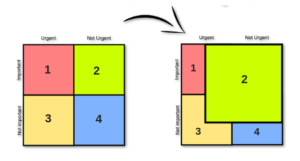 Please look over the following questions:
Please look over the following questions:
- Do you have long-term goals but no time or energy to make progress on them?
- Do you find yourself running around putting out fires all day?
- Are you usually busy but don’t feel like your work has a high impact?
- Are you having a hard time delegating and/or saying no?
If you find yourself feeling a twinge of guilt at any point while working through the questions listed above, then it’s recommended that you try Eisenhower Matrix (also known as the urgent-important matrix).
It’s a simple tool for prioritization which will help you spend the right energy and focus on the right activities at the appropriate time. Without it, there’s a tendency to fall into the urgency trap.
The urgency trap means prioritizing tasks with a deadline over tasks without one regardless of their long-term payoffs. This happens because, as studies have shown, our attention is usually drawn to time-sensitive tasks over tasks that are less urgent even when the less urgent task offers greater rewards.
So it’s not surprising that a lot of people are caught in this trap. And many of them are ‘busy’ people as they are usually fixated on task duration making them more likely to select urgent tasks with lower payouts. In any case, if you’re already feeling a time crunch, you’ll likely continue to prioritize tasks that keep you focused on the clock.
But there’s good news too – the urgency trap can be avoided. And that’s where the Eisenhower Matrix comes in.
Here are the concepts and how the matrix can be used.
All activities can be classified by its urgency (Urgent or Not Urgent) and by its importance (Important or Not Important).
Important activities are activities that will help you complete your goals.
Urgent activities are activities that demand immediate attention and often have deadlines attached to them.
Different combinations of these two create the Eisenhower Matrix with four quadrants as illustrated in Figure 1 below.

Figure 1
Quadrant 1: Activities that are important and urgent – things with clear deadlines and consequences for not taking immediate action.
For example:
- Fixing an office power generator that stopped working at peak work period
- Responding to some emails
- Working on deadline-driven clients’ projects
- Answering vital customer calls
Quadrant 2: Activities that are important but not urgent – things without a set deadline but they bring you closer to your goals.
For example:
- Strategic planning
- Capability improvement like reading, learning, and education
- Eating healthy and exercising
- Preventative maintenance on important work tools and facilities
- Forming bonds and strengthening important relationships
Quadrant 3: Activities that are urgent but not important – things that require immediate attention but do not contribute to your goals.
For example:
- Unnecessary interruptions from coworkers
- Checking and responding to WhatsApp or Facebook messages
- Attending inconsequential meetings
- Drop in visitors
Quadrant 4: Activities that are not urgent and not important – time wasting activities that make you feel worse afterward.
For example:
- Avoidance activities such as sorting and organizing emails rather than responding to them
- Irrelevant phone calls
- Workplace gossip
- Mindless online browsing and chatting
Looking at the quadrants, the one with activities that offer the greatest rewards is Quadrant 2. Hence to avoid the urgency trap, start spending more time in Quadrant 2. And to do so you need to free up the time you usually spend in other quadrants as illustrated in Figure 2 below.

Figure 2
Taking the following steps will help:
- Look at all the things in Quadrant 4 and STOP DOING THEM!
- Look at all the things in Quadrant 3 and stop doing them too. This is more difficult as it involves saying NO to people. But stop doing them. Delegate them, if possible. It’s important that you escape from this quadrant because that’s where the urgency trap is primarily domiciled.
With more time now available, channel it towards Quadrant 2 activities (important but not urgent things) before they become urgent and pop up in Quadrant 1 as pressing problems.
In Quadrant 2, where highly effective people spend most of their time, you are focused not on problems (as in Quadrant 1) but on opportunities and growth. When urgent issues arise (Quadrant 1 activities), they are truly urgent because you are proactive.
Eisenhower Matrix is indeed valuable. Not only does it help you to avoid the urgency trap, it also helps to eliminate time-wasters in your life, and creates more mental space for you to make progress on your important, longer-term goals.
“I have two kinds of problems, the urgent and the important. The urgent are not important, and the important are never urgent.” — Dwight D. Eisenhower